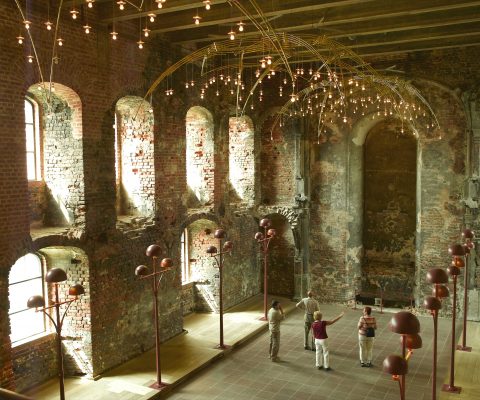The History of the Church Hall
In around 1600, King Christian IV of Denmark installed a new church hall at Koldinghus. It was placed in the north-west corner of the castle, and The Great Hall and great tower were built above it. The church design was based on northern German models: a broad nave featuring three star vaults, surrounded on three sides by a narrow gallery, two storeys of which opened out on to the nave with arcades. The fourth side, facing north, featured a tall, round-arched window, and in front of this was the altar.
The floor was tiled with black and white marble tiles, while the altarpiece and pulpit were of marble and alabaster. The king’s closed-off pew was located in the gallery across from the pulpit, and from here he was able to participate in church services. The pulpit in the north-east corner of the church rested on a lion holding the king’s coat of arms, and along the arcade were seven statues of Christ, Peter and Paul, as well as the evangelists Matthew, Mark, Luke and John.
The church hall was damaged by the Swedish army during the “Lennart Torstensson” war of 1643-45. A comprehensive restoration project was carried out during the reign of King Frederik IV, and the various passages of scripture were renewed.
When the church hall caught fire in 1808, the beams that supported the south wall of the great tower were damaged to such an extent that part of the tower collapsed and destroyed The Great Hall and the church hall. The former church hall remained exposed to the open sky until the great tower was rebuilt about 1935.
When the church hall was restored at the end of the 1970s, no attempt was made to reconstruct the former church. Four walls are all that remain of its former splendour. The restorers attempted instead to provide a suggestion of the original architectural features of the church interior. The former location of the nave is indicated by the stone floor and the three star-shaped chandeliers, while the location of the gallery and arcades is marked by the wooden floor along the three walls. Street lamps indicate the position of the wall pillars that supported the arches and gallery.
The hall is no longer consecrated as a church, but is now used by the museum for cultural purposes, primarily for exhibitions and concerts. It is also possible to be wed in the Church hall.
 Dansk
Dansk
 English
English
 Deutsch
Deutsch

